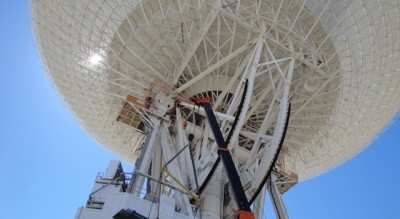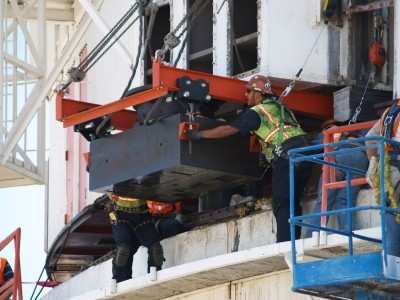Repair Required Lifting Seven Million Pounds Less Than Half An
Inch
The seven-month upgrade to the historic "Mars antenna" at NASA's
Deep Space Network site in Goldstone, CA has been completed. After
a month of intensive testing, similar to the rehabilitation stage
after "surgery", the antenna is now ready to help maintain
communication with spacecraft during the next decade of space
exploration.

70 Meter Antenna NASA Photo
The month of October was used as a testing period to make sure
the antenna was in working order and fully functional, as
scheduled, for Nov. 1. A team of workers completed an intense
series of tasks to reach its first milestone - upgrading the
230-foot-wide (70-meter) antenna in time to communicate with the
EPOXI mission spacecraft during its planned flyby of comet Hartley
2 on Nov. 4.
The first official demonstration space track was on Sept. 28,
when the antenna communicated with NASA's EPOXI mission
spacecraft.
"We've been testing the antenna since Sept. 28, and we've had no
problems in tracking the spacecraft," said Peter Hames of NASA's
Jet Propulsion Laboratory, Pasadena, CA, who is responsible for
maintaining the network's antennas. "We are ready to resume service
as scheduled." JPL manages the Deep Space Network for NASA.
During the upgrade process, workers raised a portion of the
antenna that weighs 7 million pounds up from the base by 0.2 inches
while they performed a precise, delicate repair. They replaced a
portion of the hydrostatic bearing (enabling the antenna to rotate
horizontally) and the four elevation bearings (enabling the antenna
to track up and down from the horizon).
Unlike the sterile confines of an operating room, this surgery
took place in the middle of California's Mojave Desert, a hot oasis
baked by the unforgiving desert heat. The team members were able to
cheat the heat by completing a number of the 375 tasks during early
morning and night shifts. The tasks required the team to analyze,
load, lift, install, test, analyze again and inspect.

Workers Making Repairs NASA Photo
The Deep Space Network consists of three deep-space
communication facilities positioned approximately 120 degrees of
longitude apart. In addition to the Mojave Desert location at
Goldstone, the other locations are outside of Madrid, Spain, and
Canberra, Australia. Each 70-meter antenna is capable of tracking a
spacecraft traveling more than 10 billion miles from Earth. The
antennas are strategically situated at each location in
semi-mountainous basins to reduce radio frequency interference.
This careful placement helps make the Deep Space Network the
largest and most sensitive science telecommunications system in the
world.
In March 1966, the antenna, officially known as Deep Space
Station 14, earned its nickname as the Mars antenna by receiving
the first signal from NASA's Mariner 4 mission to Mars. The
historic dish is now responsible for tracking an entire fleet of
missions, including the rovers Spirit and Opportunity currently on
the surface of Mars, the Cassini orbiter at Saturn, the twin
Voyager spacecraft in the outer reaches of our solar system, and
the Spitzer Space Telescope, which observes stars, galaxies and
other celestial objects.
"We are nearing the completion of a very challenging engineering
effort that will extend the life of one of the DSN's workhorses,
making it more available and reliable in returning critical science
data through at least 2025," said Wayne Sible, the network's deputy
project manager at JPL.
"The 70-meter antenna gets under your skin, everyone involved in
this project was so passionate about it, from the grout workers to
the machine shops to the guys on the antenna, everybody was giving
it their absolute all," said Hames.
 ANN's Daily Aero-Term (04.30.24): Runway Centerline Lighting
ANN's Daily Aero-Term (04.30.24): Runway Centerline Lighting ANN's Daily Aero-Linx (04.30.24)
ANN's Daily Aero-Linx (04.30.24) Airborne 04.24.24: INTEGRAL E, Elixir USA, M700 RVSM
Airborne 04.24.24: INTEGRAL E, Elixir USA, M700 RVSM Airborne 04.29.24: EAA B-25 Rides, Textron 2024, G700 Deliveries
Airborne 04.29.24: EAA B-25 Rides, Textron 2024, G700 Deliveries Airborne-NextGen 04.23.24: UAVOS UVH 170, magni650 Engine, World eVTOL Directory
Airborne-NextGen 04.23.24: UAVOS UVH 170, magni650 Engine, World eVTOL Directory




